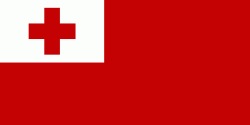Niuafo'ou
Niuafoou (meaning many new coconuts) is the northernmost island in the kingdom of Tonga. One of the Niua Islands, it is located in the southern Pacific Ocean between Fiji and Samoa, 574 km north of Tongatapu island group and 337 km northwest of Vavaʻu. It is a volcanic rim island with an area of 15 km2 and a population of 431 (as of 2021). The volcano is active and has erupted regularly since 1814, with its last major eruption in 1985.
The Niuafoʻou language is spoken on the island.
Niuafoou is a volcano located on an underwater ridge 190 km west of the line along which all the other volcanoes of Tonga are ranged. The island contains a steep-sided caldera; its rim is over 120 m high. It rises to a height of 250 m at Mokotu. The coastline is rocky and steep, with only a few beaches, all of which are stony, with black sand. The only landing place on the island is at the end of a lava flow in Futu, which is in the western part of the island. All the villages are in the north and east. Public places—like the post office, telecommunications station and airport (Kuini Lavinia Airport)—are in Angahā in the north; there’s a high school in Mua.
The island ring encloses two lakes. The larger one, Vai Lahi, is a crater lake 23 m above sea level, 4 km wide, and 84 m deep. It contains three islands and a submerged island that appears when the water level drops. Vai Lahi is separated from the smaller lake, Vai Siʻi (or Vai Mataʻaho), by a desolate landscape of sand hills. The inner walls of the crater lake, and the island's eastern and western slopes, are forested.
The Niuafoʻou language is spoken on the island.
Niuafoou is a volcano located on an underwater ridge 190 km west of the line along which all the other volcanoes of Tonga are ranged. The island contains a steep-sided caldera; its rim is over 120 m high. It rises to a height of 250 m at Mokotu. The coastline is rocky and steep, with only a few beaches, all of which are stony, with black sand. The only landing place on the island is at the end of a lava flow in Futu, which is in the western part of the island. All the villages are in the north and east. Public places—like the post office, telecommunications station and airport (Kuini Lavinia Airport)—are in Angahā in the north; there’s a high school in Mua.
The island ring encloses two lakes. The larger one, Vai Lahi, is a crater lake 23 m above sea level, 4 km wide, and 84 m deep. It contains three islands and a submerged island that appears when the water level drops. Vai Lahi is separated from the smaller lake, Vai Siʻi (or Vai Mataʻaho), by a desolate landscape of sand hills. The inner walls of the crater lake, and the island's eastern and western slopes, are forested.
Map - Niuafo'ou
Map
Country - Tonga
 |
 |
| Flag of Tonga | |
First inhabited roughly 2,500 years ago by the Lapita civilization, Tonga's Polynesian settlers gradually evolved a distinct and strong ethnic identity, language, and culture as the Tongan people. They were quick to establish a powerful footing across the South Pacific, and this period of Tongan expansionism and colonization is known as the Tuʻi Tonga Empire. From the rule of the first Tongan king, ʻAhoʻeitu, Tonga grew into a regional power. It was a thalassocracy that conquered and controlled unprecedented swathes of the Pacific, from parts of the Solomon Islands and the whole of New Caledonia and Fiji in the west to Samoa and Niue and even as far as parts of modern-day French Polynesia in the east. Tuʻi Tonga became renowned for its economic, ethnic, and cultural influence over the Pacific, which remained strong even after the Samoan revolution of the 13th century and Europeans' discovery of the islands in 1616.
Currency / Language
| ISO | Currency | Symbol | Significant figures |
|---|---|---|---|
| TOP | Tongan paʻanga | T$ | 2 |
| ISO | Language |
|---|---|
| EN | English language |
| TO | Tongan language |















